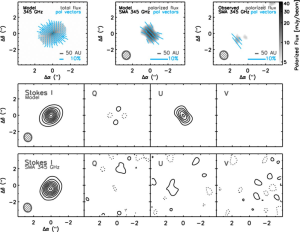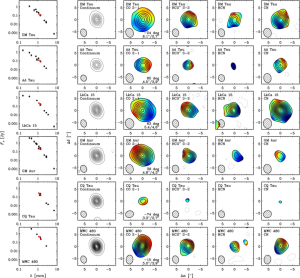 |
Dust Diagnostics of Grain Growth and Magnetic Fields
How, where and when dust grains grow and settle determines the production of planetesimals and the rocky cores of planets. The wavelengths accessible to the SMA are among the longest wavelengths where dust emission is readily detectable, and therefore the last direct link on the chain of sizes from sub-micron interstellar particles to planetesimals. For optically thin emission, measurements of the spectral slope at millimeter wavelengths reveal the spectral dependence of the mass opacity, which provides constraints on the particle properties. Analysis of multi-wavelength observations provides strong evidence for grain growth to millimeter sizes. The magnetic properties of circumstellar disks are central to a wide range of physical processes relevant to planet formation, including dust and gas transport and mixing, the migration of planetary embryos, and the magneto-hydrodynamic turbulence responsible for viscous accretion. The SMA is uniquely capable of providing constraints on magnetic field morphology through the observation of linear polarization emission from grains aligned by magnetic fields. In disks, both low signal-to-noise observations with the JCMT and theoretical models of grain alignment with magnetic fields suggest a 2 to 3% polarization fraction. The SMA polarimeter has made it possible to test these models, and has recently set very stringent limits on polarization for two disks, nearly an order of magnitude below the expectations (Hughes et al. 2009).
 |
Click here for larger view |
Figure 3: Comparison between the Cho & Lazarian (2007) model and the SMA 340 GHz observations of HD 163296. The top row shows the prediction for the model at full resolution (left), a simulated observation of the model with the SMA (center), and the 2008 SMA observations (right). The gray scale shows either the total flux (left) or the polarized flux (center, right), and the blue vectors indicate the percentage and direction of polarized flux at half-beam intervals. The center and bottom rows compare the model prediction (center) with the observed SMA data (bottom) in each of the four Stokes parameters (I, Q, U, V, from left to right). Contour levels are the same in both rows, either multiples of 10% of the peak flux (0.9 Jy beam-1) in Stokes I or in increments of 2 for Q, U, and V, where is the rms noise of 2.4 mJy beam-1. The size and orientation of the synthesized beam are indicated in the lower left of each panel (Hughes et al. 2009). |
Disk Chemistry
Understanding chemical processes in disks is essential for constructing self-consistent physical models, to analyze heating and cooling mechanisms, and to make connections with meteoritic material. Disk chemistry is a complex topic, plagued by major uncertainties in disk structure, the influence of dust, mixing processes, and even poor knowledge of basic chemical rate coefficients. The current paradigm is a layered structure with a cold mid-plane where molecules are frozen out (with the important exception of H3+ and its deuterated forms), a warm molecular layer, and a photodissocation region at the surface. The SMA has imaged over a dozen lines from simple molecules in the nearby TW Hya disk (Qi et al. 2004, 2006, 2008). To study the distribution of these molecules and to test the chemical models, an elaborate analysis framework has been developed that uses a physical structure derived from the full spectral energy distribution, and 2D radiative transfer to fit for various parameters, including fractional abundances. The results have been compared with detailed chemical models to investigate many issues, for example depletion (required to explain CO emission), the gas temperature structure (higher at large scale heights, to explain the CO isotopologue emission, and higher than the dust temperature at large scale heights, to explain the relative strengths of the CO 2-1, 3-2, and 6-5 emission), the deuterium fraction (higher in the outer disk where temperatures are low and CO depletion prevails), and photodissociation (HCN is dissociated by stellar Lymanα photons, which gives rise to strong CN emission). In the cold, dense mid-plane, only H2D+ and D2H+ are expected to be abundant. These species, which are uniquely accessible to the SMA for interferometry, offer the best, and possibly only, means to probe the midplane gas kinematics and ionization fraction. Preliminary observations of H2D+ emission at 372 GHz in TW Hya, made with just a few antennas, provided useful constraints, but much work remains. A new disk chemistry survey for about a dozen disks is currently underway with the SMA (see Öberg et al. 2010).
 |
Click here for larger view |
Figure 4: Literature SEDs with our continuum points superimposed in red (Column 1), 267 GHz continuum maps (Column 2), and zero- and first-moment maps of CO 2-1, HCO+ 3-2, HCN 3-2, and CN 2-1 (Columns 3-6). In the moment maps, the contours show the integrated intensity in steps of 0.8, 0.5, 0.32, and 0.32 Jy beam-1 km s-1 for CO, HCO+, HCN, and CN, respectively. The velocity gradient is defined over the same range for all molecules toward each source. The derived P.A.s and CO FHWM major and minor axes derived from fitting ellipses to the CO maps are shown in the lower right corner of each CO panel (Öberg et al. 2010). |
» Next Page: Orion Proplyds
« Previous Page
SMA Research
| |
| |



